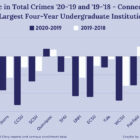Generation Health
Universities Take Steps To Raise Awareness Of Monkeypox
|
Colleges statewide have taken steps to educate and raise awareness about monkeypox, a virus with over 21,900 cases nationally. At Wesleyan University, for example, an e-mail was sent to all students that provides links to the university’s health services website explaining the virus and how to access counseling and vaccines, if needed. Other colleges, such as Yale University, the University of Connecticut and Southern Connecticut State University, have web pages dedicated to information on monkeypox. Nationally, there have been a handful of cases reported at various colleges, but none among Connecticut college students. Overall, as of Sept. 12, there were 21,985 cases of monkeypox reported in the U.S., and 113 cases in Connecticut, according to the Centers for Disease Control and Prevention (CDC).



